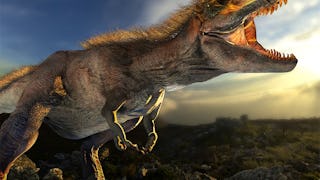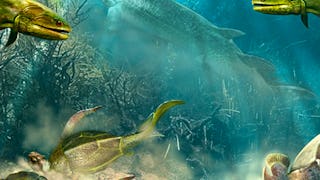Paléontologie : Les dinosaures théropodes et l'origine des oiseaux est un cours en cinq leçons qui donne une vue d'ensemble des origines des oiseaux. Ce cours examine l'anatomie, la diversité et l'évolution des dinosaures théropodes en relation avec l'origine des oiseaux. Les étudiants explorent diverses hypothèses sur l'origine du vol. Regardez un aperçu du cours ici : https://uofa.ualberta.ca/courses/paleontology-theropod-dinosaurs



Paléontologie : Les dinosaures théropodes et l'origine des oiseaux

Instructeur : Philip John Currie, Ph.D
Enseignant de premier plan
31 933 déjà inscrits
Inclus avec 
(1,545 avis)
Compétences que vous acquerrez
- Catégorie : Taxonomie
- Catégorie : Sciences de la vie
Détails à connaître

Ajouter à votre profil LinkedIn
5 devoirs
Découvrez comment les employés des entreprises prestigieuses maîtrisent des compétences recherchées


Obtenez un certificat professionnel
Ajoutez cette qualification à votre profil LinkedIn ou à votre CV
Partagez-le sur les réseaux sociaux et dans votre évaluation de performance

Il y a 5 modules dans ce cours
Dans la leçon 1, nous explorons l'anatomie et les adaptations des oiseaux et nous rencontrons les scientifiques de l'époque victorienne qui ont été les premiers à soupçonner le lien entre les terribles lézards et les oiseaux modernes. Pour pouvoir voler, les oiseaux ont subi une série de spécialisations anatomiques qui les distinguent des autres vertébrés. Toutefois, la plupart des caractéristiques anatomiques les plus frappantes et les plus inhabituelles des oiseaux sont apparues il y a plus de 230 millions d'années avec les premiers dinosaures théropodes. Une petite remarque avant de commencer : palaios est le mot grec qui signifie "ancien". La paléontologie ou la paléontologie est donc l'étude de la vie ancienne. Les deux orthographes sont correctes, paléontologie étant utilisé en Grande-Bretagne et paléontologie étant plus courant aux États-Unis.
Inclus
3 vidéos6 lectures1 devoir
Au lendemain de l'extinction massive du Permien, le monde préhistorique était mûr pour la conquête. Toutes les masses continentales du monde ont été regroupées en un seul supercontinent : la Pangée : Pangée. En l'absence de mers, de nouvelles lignées d'animaux terrestres ont pu exploiter de nouveaux habitats sur l'ensemble du globe. Les archosaures, qui signifient "reptiles dominants", en sont venus à dominer les écosystèmes du Trias. Cependant, les archosaures dinosauriens n'étaient pas les principaux prédateurs. Ce sont les crurotariens qui se sont installés sans conteste au sommet de la chaîne alimentaire. Les premiers théropodes étaient des carnivores petits mais agiles, et bien qu'ils aient commencé par être l'équivalent darwinien des employés de bureau, à la période géologique suivante (le Jurassique), ils étaient grands et en charge. Dans la leçon 2, nous vous présenterons quelques-uns des premiers théropodes et explorerons les secrets anatomiques de leur survie et de leur succès. Nous rencontrerons également les plus grands prédateurs terrestres de tous les temps.
Inclus
3 vidéos1 lecture1 devoir
Dans la leçon précédente, nous avons exploré comment les différentes lignées de théropodes se sont adaptées à leur rôle de prédateurs supérieurs. Dans cette leçon, nous allons explorer un nouveau groupe de théropodes, caractérisés par leur vitesse et leur agilité autant que par leurs prouesses de prédateurs. Les coelurosaures étaient les plus prospères et les plus diversifiés de tous les théropodes. Ils comprenaient des herbivores, les plus petits de tous les dinosaures et, bien sûr, les puissants tyrannosaures.
Inclus
4 vidéos1 lecture1 devoir
Les dinosaures ont longtemps été considérés comme des reptiles surdimensionnés, à sang froid, liés aux marais, dotés d'une intelligence médiocre et d'une complexité sociale faible, voire inexistante. La "Renaissance des dinosaures" a été une révolution dans la pensée paléontologique qui a entièrement transformé l'image traditionnelle des dinosaures. Dans la leçon 4, nous verrons comment les nouvelles recherches et découvertes des cinquante dernières années ont façonné l'image moderne des dinosaures : celle d'animaux énergiques et intelligents, qui présentaient probablement un grand nombre des comportements sociaux complexes observés chez les oiseaux modernes. Vous rencontrerez également les déinonychosaures, également appelés "rapaces", et vous découvrirez les principales théories expliquant comment un groupe de dinosaures a appris à voler.
Inclus
3 vidéos1 lecture1 devoir
il y a 66 millions d'années, un astéroïde plus grand que le mont Everest est entré en collision avec la Terre et a provoqué l'extinction des dinosaures... à l'exception des oiseaux ! Maintenant que vous connaissez certains de leurs grands ancêtres mésozoïques et leurs caractéristiques similaires à celles des oiseaux, il est temps de faire connaissance avec la lignée aviaire proprement dite. Grâce à l'évolution du vol, les oiseaux ont pu exploiter des habitats et des ressources qui étaient littéralement inaccessibles aux autres animaux. L'évolution des oiseaux a été marquée par la diversification. L'incapacité de voler a évolué à de nombreuses reprises, tout comme les spécialisations dans l'insectivorie, la natation et la prédation. Si les théropodes ne dominent plus la terre, ils dominent toujours le ciel.
Inclus
3 vidéos1 lecture1 devoir
Instructeur

Offert par
En savoir plus sur Science fondamentale


American Museum of Natural History


University of Alberta


University of Alberta


University of Alberta
Pour quelles raisons les étudiants sur Coursera nous choisissent-ils pour leur carrière ?




Avis des étudiants
1 545 avis
- 5 stars
90,94 %
- 4 stars
7,95 %
- 3 stars
0,97 %
- 2 stars
0,06 %
- 1 star
0,06 %
Affichage de 3 sur 1545
Révisé le 10 mars 2021
Excellent course! Very thorough. Very knowledgable presenters. Loved how well the course was laid out. I with there could be more interactive activities like the dinosaur foot!
Révisé le 1 déc. 2020
Originally took the class to keep up with my daughter who is in the childhood Paleontology phase. However, I found the class to be very informative and learned way more than I was expecting.
Révisé le 23 juil. 2023
Excellent course, fun course, very informative. The enthusiasm of both instructors was infectious. I highly recommend this course for anyone interested in dinasaurs and/or birds.

Ouvrez de nouvelles portes avec Coursera Plus
Accès illimité à 10,000+ cours de niveau international, projets pratiques et programmes de certification prêts à l'emploi - tous inclus dans votre abonnement.
Faites progresser votre carrière avec un diplôme en ligne
Obtenez un diplôme auprès d’universités de renommée mondiale - 100 % en ligne
Rejoignez plus de 3 400 entreprises mondiales qui ont choisi Coursera pour les affaires
Améliorez les compétences de vos employés pour exceller dans l’économie numérique
Foire Aux Questions
L'accès aux cours et aux devoirs dépend de votre type d'inscription. Si vous suivez un cours en mode audit, vous pourrez consulter gratuitement la plupart des supports de cours. Pour accéder aux devoirs notés et obtenir un certificat, vous devrez acheter l'expérience de certificat, pendant ou après votre audit. Si vous ne voyez pas l'option d'audit :
Il se peut que le cours ne propose pas d'option d'audit. Vous pouvez essayer un essai gratuit ou demander une aide financière.
Le cours peut proposer l'option "Cours complet, pas de certificat" à la place. Cette option vous permet de consulter tous les supports de cours, de soumettre les évaluations requises et d'obtenir une note finale. Cela signifie également que vous ne pourrez pas acheter un certificat d'expérience.
Lorsque vous achetez un certificat, vous avez accès à tous les supports de cours, y compris les devoirs notés. Une fois le cours terminé, votre certificat électronique sera ajouté à votre page de réalisations. Vous pourrez alors l'imprimer ou l'ajouter à votre profil LinkedIn. Si vous souhaitez uniquement lire et visualiser le contenu du cours, vous pouvez l'auditer gratuitement.
Vous pouvez prétendre à un remboursement intégral jusqu'à deux semaines après la date de votre paiement ou (pour les cours qui viennent d'être lancés) jusqu'à deux semaines après le début de la première session du cours, la date la plus tardive étant retenue. Vous ne pouvez pas obtenir de remboursement une fois que vous avez obtenu un certificat de cours, même si vous terminez le cours pendant la période de remboursement de deux semaines. Consultez notre politique de remboursement complète.
Plus de questions
Aide financière disponible,

